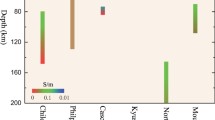Summary
Dilatancy may lower pore pressure at mid-crustal depths to near the liquid-vapor transition of water. However, the resistivity of typical pore fluids changes very little down the transition so that changes in rock resistivity will be almost solely due to dilatant volume change. Experiments with partly saturated rocks at room temperature suggest that rocks containing mixtures of fluid and vapor, along the transition, will generally behave electrically during dilatancy as though they were fluid saturated. Observed resistivity changes before earthquakes give the dilatant volume change directly and thus may be used to further constrain the dilatancy-diffusion model, independent of observed uplift or velocity changes.
Similar content being viewed by others
References
D. L. Anderson andJ. H. Whitcomb,The dilatancy-diffusion model of earthquake prediction, in Proc. of Conf on Tectonic Problems of the San Andreas Fault System, edited byR. L. Kovach andA. Nur (Stanford Univ. Press, California 1973), p. 417.
T. C. Hanks,Constraints on the dilatancy-diffusion model of the earthquake mechanism, J. Geophys. Res.79 (1974), 3023.
A. Nur,Matsushiro, Japan, earthquake swarm: Confirmation of the dilatancy-fluid diffusion model, Geology2 (1974), 217.
O. M. Barsukov,Relationship between the electrical resistivity of rocks and tectonic processes, Izv. Earth Physics, No. 1 (1970), 84.
A. Mazzella andH. F. Morrison,Electrical resistivity variations associated with earthquakes on the San Andreas fault. Science185 (1974), 855.
W. F. Brace,Resistivity of saturated crustal rocks to 40 km based on laboratory measurements, Geophysical Monograph Series Vol. 14 (Amer. Geophys. Un., Washington 1971), p. 243.
T. Mitchell andW. F. Brace,Electrical resistivity of partially saturated rocks (Abstract), Trans. Amer. Geophys. Un.54 (1973), p. 1209.
A. S. Quist,The ionization constant of water to 800° and 4000 bars, J. Phys. Chem.74 (1970), 3396.
G. C. Kennedy andW. T. Holser,Pressure-volume-temperature and phase relations of water and carbon dioxide, Handbook of Physical Constants, Geol. Soc. Amer. Mem.97 (1966), 371.
A. S. Quist andW. L. Marshall,The electrical conductances of some alkali metal halides in aqueous solutions from 0 to 800° and at pressures to 4000 bars. J. Phys. Chem.73 (1969), 978.
A. S. Quist, W. L. Marshall, E. U. Franck andW. Von Osten,A reference solution for electrical conductance measurements to 800° and 12 000 bars. Aqueous 0.01 demal potassium chloride, J. Phys. Chem.74 (1970), 2241.
J. K. Fogo, S. W. Benson andC. S. Copeland,The electrical conductivity of supercritical solutions of sodium chloride and water. J. Chem. Phys.22 (1954), 212.
W. F. Brace andA. S. Orange,Electrical resistivity changes in saturated rocks during fracture and frictional sliding, J. Geophys. Res.73 (1968), 1433.
M. Zoback andJ. D. Byerlee,The effect of cyclic differential stress on dilatancy in Westerly granite under uniaxial and triaxial conditions. J. Geophys. Res.80 (1975), 1526–1530.
C. H. Scholz andR. Kranz,Notes on dilatancy recovery, J. Geophys. Res.79 (1974), 2132.
E. S. Sprunt andW. F. Brace,Direct observation of microcavities in crystalline rocks, Int. J. Rock Mech. Min. Sci. & Geomech. Abst.11 (1974), 139.
T. R. Madden, Personal communication (June, 1974).
E. I. Parkhomenko,Electrical Properties of Rocks (Plenum Press, New York 1967).
J. E. Russell andE. R. Hoskins,Correlation of electrical resistivity of dry rock with cumulative damage, Proc., 11th Sympos. on Rock Mechanics, Berkeley, June 1969 (SME & AIMMPE, New York 1970), p. 213.
A. Nur, P. M. Bell andP. Talwani,Fluid flow and faulting, 1: A detailed study of the dilatancy mechanism and premonitory velocity changes, in Proc. of Conf. on Tectonic Problems of the San Andreas Fault System, edited byR. L. Kovach andA. Nur (Stanford University Press, California 1973), p. 391.
K. Hadley,Laboratory investigation of dilatancy and motion on fault surfaces at low confining pressures, in Proc. of Conf. on Tectonic Problems of the San Andreas Fault System, edited byR. L. Kovach andA. Nur (Stanford Univ. Press, California 1973), p. 427.
W. F. Brace, A. S. Orange andT. R. Madden,The effect of pressure on the electrical resistivity of water-saturated crystalline rocks. J. Geophys. Res.70 (1965), 5669.
W. F. Brace andA. S. Orange,Further studies of the effect of pressure on electrical resistivity of rocks, J. Geophys. Res.73 (1968), 5407.
A. Nur andG. Simmons,The origin of small cracks in igneous rocks, Int. J. Rock Mech. Min. Sci.7 (1970), 307.
D. T. Snow,Rock fracture spacings, openings and porosities, J. Soil Mech. Found. ASCE94 (1968), 73.
C. Montgomery andW. F. Brace,Micropores in plagioclase, Contr. Min. Pet. (1974), in press.
Rights and permissions
About this article
Cite this article
Brace, W.F. Dilatancy-related electrical resistivity changes in rocks. PAGEOPH 113, 207–217 (1975). https://doi.org/10.1007/BF01592911
Received:
Issue Date:
DOI: https://doi.org/10.1007/BF01592911




